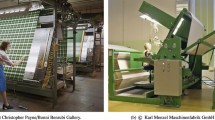Abstract
Template matching methods have been widely utilized to detect fabric defects in textile quality control. In this paper, a novel approach is proposed to design a flexible classifier for distinguishing flaws from twill fabrics by statistically learning from the normal fabric texture. Statistical information of natural and normal texture of the fabric can be extracted via collecting and analyzing the gray image. On the basis of this, both judging threshold and template are acquired and updated adaptively in real-time according to the real textures of fabric, which promises more flexibility and universality. The algorithms are experimented with images of fault free and faulty textile samples.
Similar content being viewed by others
References
B. Smith. Six-sigma design. IEEE Spectrum, vol. 30, no. 9, pp. 43–47, 1993.
M. Bennamoun, A. Bodnarova. Automatic visual inspection and flaw detection in textile materials: Past, present and future. In Proceedigs of IEEE International Conference on Systems, Man, Cybernetics, IEEE, San Diego, USA, vol. 5, pp. 4340–4343, 1998.
H. Sari-Sarraf, J. S. Goddard. Vision system for on-loom fabric inspection. IEEE Transactions on Industry Applications, vol. 35, no. 6, pp. 1252–1259, 1999.
R. M. Haralick, K. Shanmugam, I. Dinstein. Texture features for image classification. IEEE Transactions on Systems, Man, and Cybernetics, vol. 3, no. 6, pp. 610–621, 1973.
B. Julesz. Visual pattern discrimination. IRE Transactions on Information Theory, vol. 8, no. 2, pp. 84–92, 1962.
F. S. Cohen, Z. Fan, S. Attali. Automated inspection of textile fabrics using textural models. IEEE Transactions on Pattern Analysis and Machine Intelligence, vol. 13, no. 8, pp. 803–808, 1991.
S. A. H. Ravandi, K. Toriumi, Y. Matsumoto. Fourier transform analysis of plain weave fabric appearance. Textile Research Journal, vol. 65, no. 11, pp. 676–683, 1995.
A. Bodnarova, M. Bennamoun, S. J. Latham. A constrained minimisation approach to optimise Gabor filters for detecting flaws in woven textiles. In Proceedings of IEEE International Conference on Acoustics, Speech, and Signal Processing, vol. 6, pp. 3606–3609, 2000.
W. J. Jasper, H. Potlapalli. Image analysis of mispicks in woven fabric. Textile Research Journal, vol. 65, no. 11, pp. 683–692, 1995.
S. C. Kim, T. J. Kang. Automatic evaluation of fabric pilling using a 3-D non-contact scanning system. In Proceedings of IEEE Instrumentation and Measurement Technology Conference, IEEE, Ottawa, Canada, vol. 1, pp. 628–632, 2005.
B. Xin, J. Hu, H. Yan. Objective evaluation of fabric pilling using image analysis techniques. Textile Research Journal, vol. 72, no. 12, pp. 1057–1064, 2002.
L. W. Han, D. Xu, L. K. Wang. Adaptive detection of fabric flaw based on statistical information. Chinese Journal of Electron Devices, vol. 31, no. 3, pp. 979–983, 2008. (in Chinese)
X. Y. Wang, J. Wu. A feature-based robust digital image watermarking against desynchronization attacks. International Journal of Automation and Computing, vol. 4, no. 4, pp. 428–432, 2007.
S. M. Zhou, J. Q. Gan, L. D. Xu, R. John. Interactive image enhancement by fuzzy relaxation. International Journal of Automation and Computing, vol. 4, no. 3, pp. 229–235, 2007.
N. Otsu. A threshold selection method from gray-level histogram. IEEE Transactions on Systems, Man, and Cybernetics, vol. 9, no. 1, pp. 62–66, 1979.
Author information
Authors and Affiliations
Corresponding author
Additional information
This work was supported by National Natural Science Foundation of China (No. 60672039).
Li-Wei Han received the B. Sc. degree in computer science from the University of Science and Technology Beijing, Beijing, PRC in 1994. He is currently a Ph.D. candidate at the Institute of Automation, the Chinese Academy of Sciences, Beijing, PRC.
His research interests include image processing and visual positioning of mobile robot.
De Xu received the B. Sc. and M. Sc. degrees from the Shandong University of Technology, Jinan, PRC in 1985 and 1990, respectively, and the Ph.D. degree from Zhejiang University, Hangzhou, PRC in 2001, all in control science and engineering. Since 2001, he has been with the Institute of Automation, the Chinese Academy of Sciences, Beijing, PRC. He is currently a professor at the Laboratory of Complex Systems and Intelligence Science, the Institute of Automation, the Chinese Academy of Sciences.
His research interests include robotics and automation, especially the control of robots such as visual-control and intelligent control.
Rights and permissions
About this article
Cite this article
Han, LW., Xu, D. Statistic learning-based defect detection for twill fabrics. Int. J. Autom. Comput. 7, 86–94 (2010). https://doi.org/10.1007/s11633-010-0086-7
Received:
Revised:
Published:
Issue Date:
DOI: https://doi.org/10.1007/s11633-010-0086-7




